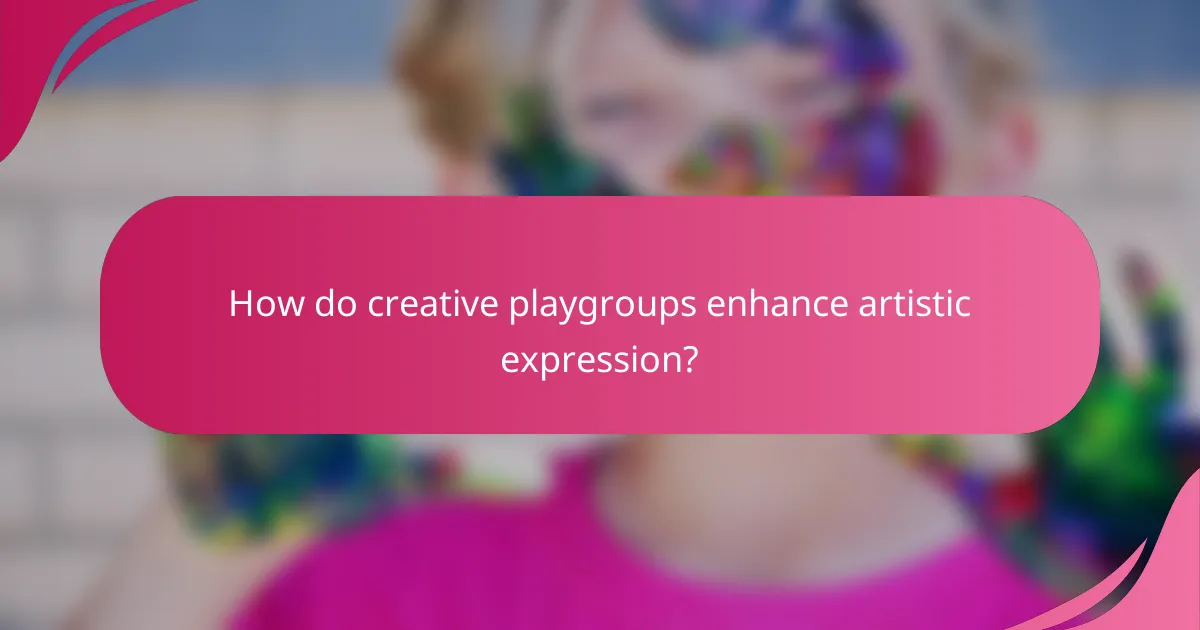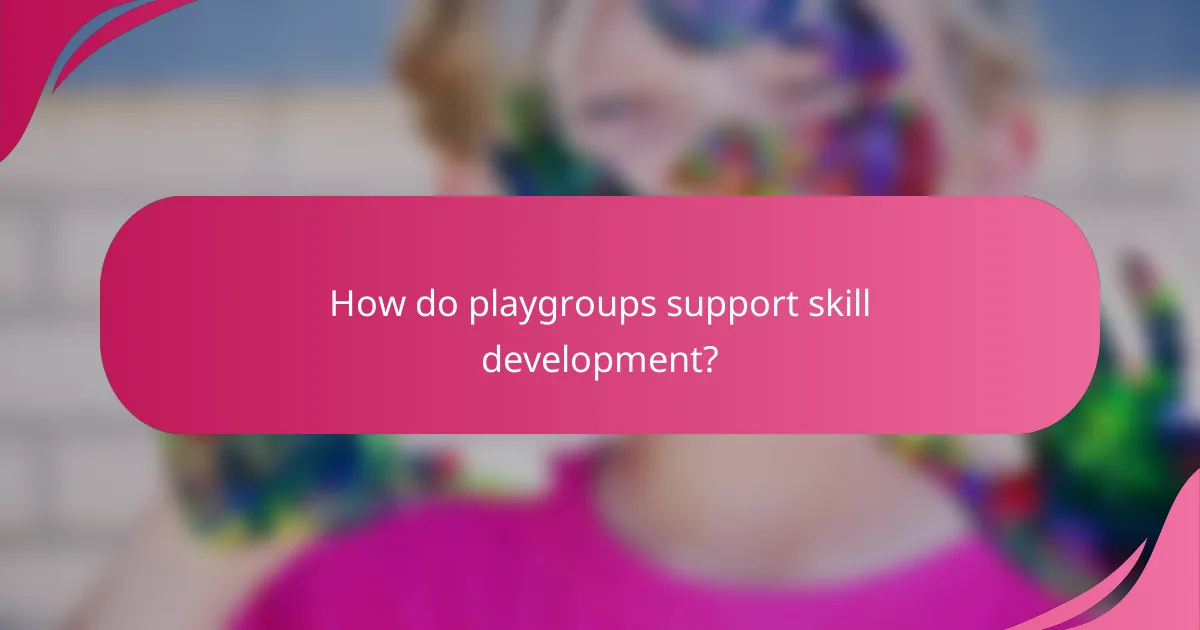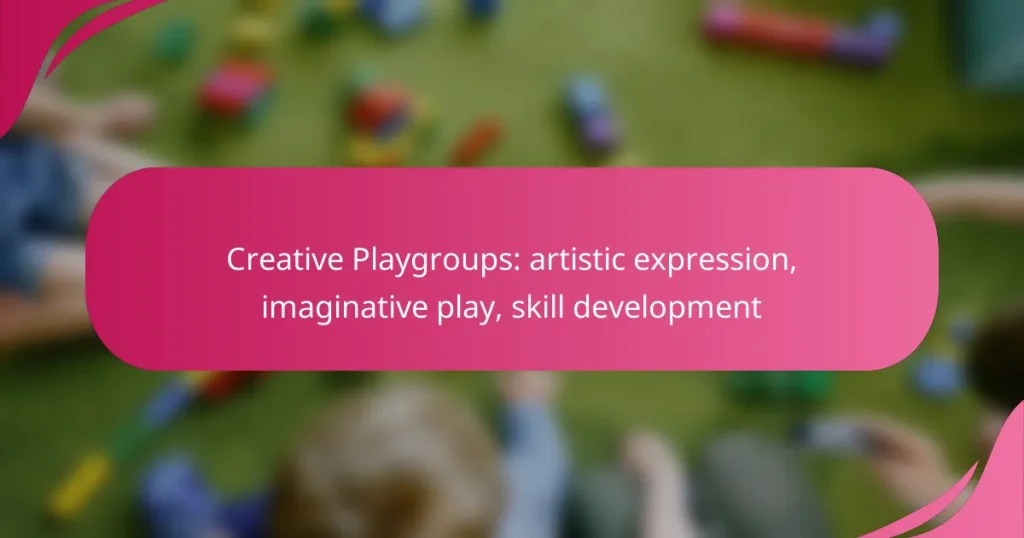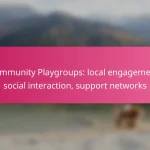Creative playgroups offer a vibrant space for children to explore artistic expression and imaginative play, fostering their creativity through structured activities. By engaging in role-playing, storytelling, and collaborative projects, children not only enhance their artistic skills but also develop critical problem-solving and social abilities essential for their growth.

How do creative playgroups enhance artistic expression?
Creative playgroups enhance artistic expression by providing structured environments where children can explore their imagination through various artistic activities. These groups foster creativity, allowing children to engage in imaginative play while developing essential skills like problem-solving and collaboration.
Improved creativity through guided activities
Guided activities in creative playgroups stimulate children’s imagination by introducing them to diverse art forms such as painting, sculpting, and storytelling. These activities are designed to challenge their thinking and encourage them to experiment with different materials and techniques.
For example, a session might involve creating a mural where children can express their ideas collectively, enhancing their creative output while learning to work as a team. Such structured experiences can significantly boost their creative confidence and willingness to explore new concepts.
Encouragement of self-expression in children
Creative playgroups prioritize self-expression, allowing children to communicate their thoughts and feelings through art. This freedom to express themselves helps them develop a stronger sense of identity and emotional intelligence.
Activities like improvisational theater or personal art projects enable children to share their unique perspectives, fostering a supportive environment where individual voices are valued. This encouragement can lead to increased self-esteem and a more profound appreciation for their creative abilities.
Collaboration with local artists
Collaborating with local artists in creative playgroups provides children with real-world insights into the artistic process. These artists can share their expertise, techniques, and experiences, enriching the children’s understanding of art and creativity.
Workshops led by local artists can include hands-on projects, where children learn to create art using professional methods. This exposure not only enhances their skills but also inspires them to pursue their artistic interests further, potentially leading to lifelong passions or careers in the arts.

What types of imaginative play are encouraged in playgroups?
Imaginative play in playgroups includes various activities that stimulate creativity and social skills. These activities often involve role-playing, storytelling, and dramatic scenarios, allowing children to express themselves and develop essential life skills.
Dramatic play scenarios
Dramatic play scenarios allow children to act out different roles and situations, fostering creativity and empathy. Common examples include playing house, pretending to be animals, or reenacting favorite stories. These scenarios help children understand social dynamics and improve their communication skills.
To enhance dramatic play, provide costumes, props, and a designated space where children can freely explore their imaginations. Encourage them to collaborate and create their own narratives, which can lead to richer experiences.
Role-playing activities
Role-playing activities involve children taking on specific roles, such as a doctor, teacher, or superhero. This type of play encourages problem-solving and critical thinking as children navigate various scenarios. For instance, a doctor role-play can teach empathy and the importance of caring for others.
Facilitate role-playing by offering a variety of costumes and props relevant to different professions or characters. Allow children to switch roles frequently, which can enhance their adaptability and understanding of diverse perspectives.
Storytelling sessions
Storytelling sessions provide a platform for children to share their ideas and narratives, enhancing their language skills and imagination. These sessions can involve reading books, telling personal stories, or creating new tales together. Engaging children in storytelling helps them develop a sense of narrative structure and boosts their confidence in public speaking.
To make storytelling more interactive, encourage children to illustrate their stories or act them out. This not only reinforces comprehension but also adds a visual element that can captivate their peers. Consider incorporating cultural stories to broaden their understanding of different backgrounds and traditions.

How do playgroups support skill development?
Playgroups foster skill development by providing children with opportunities to engage in creative activities and social interactions. These experiences enhance various skills, including fine motor, social, and cognitive abilities, essential for their overall growth.
Fine motor skills through art projects
Art projects in playgroups are excellent for developing fine motor skills. Activities like painting, drawing, and crafting require children to use their hands and fingers in precise ways, improving coordination and dexterity. Simple tasks such as cutting paper or threading beads can significantly enhance these skills.
To maximize benefits, encourage children to use a variety of tools, such as brushes, scissors, and clay. This variety not only makes activities more engaging but also challenges their motor skills in different contexts.
Social skills via group interactions
Group interactions in playgroups are crucial for developing social skills. Children learn to communicate, share, and collaborate with peers, which fosters teamwork and empathy. Engaging in group games or collaborative art projects helps them understand social cues and build friendships.
To support social development, create structured activities that require teamwork, such as building a group mural or participating in a circle game. These activities encourage children to express themselves and respect others’ ideas, enhancing their social competence.
Cognitive skills through problem-solving games
Problem-solving games in playgroups stimulate cognitive skills by challenging children to think critically and creatively. Activities like puzzles, scavenger hunts, or building challenges require them to strategize and make decisions, enhancing their analytical thinking.
Incorporate a mix of individual and group problem-solving tasks to cater to different learning styles. For instance, use simple logic games or riddles that encourage discussion and collective reasoning, helping children develop their cognitive abilities in a fun and engaging way.

What are the prerequisites for joining a creative playgroup?
Joining a creative playgroup typically requires meeting specific age criteria, ensuring parental involvement, and completing a registration process. These prerequisites help create a supportive environment for artistic expression and skill development.
Age requirements for participation
Most creative playgroups cater to children aged between 2 and 6 years, although some may accept slightly older or younger participants. It’s essential to check the specific age range set by the playgroup, as this can influence the activities and developmental focus.
Age-appropriate activities are designed to match children’s developmental stages, ensuring they benefit fully from imaginative play and artistic expression. For example, younger children may engage in simple crafts, while older kids might explore more complex projects.
Parental involvement expectations
Parental involvement is often a key component of creative playgroups. Many programs require at least one parent or guardian to participate in sessions, helping to facilitate activities and support their child’s engagement.
This involvement not only enhances the child’s experience but also fosters a sense of community among parents. Parents should be prepared to assist with setup, cleanup, and occasionally lead activities, depending on the group’s structure.
Registration process details
To register for a creative playgroup, parents typically need to fill out an application form and pay a fee, which can range from a nominal amount to a few hundred dollars depending on the program’s duration and offerings. Some playgroups may also require a trial session before full enrollment.
It’s advisable to register early, as spots can fill quickly, especially in popular areas. Parents should also inquire about any necessary materials or supplies their child may need to bring to sessions, ensuring a smooth start to the program.

How to choose the right creative playgroup for your child?
Selecting the right creative playgroup involves assessing the program’s structure, evaluating instructor qualifications, and considering location and accessibility. These factors ensure that your child engages in artistic expression, imaginative play, and skill development in a supportive environment.
Assessing program structure and curriculum
When evaluating a creative playgroup, examine its program structure and curriculum to ensure it aligns with your child’s interests and developmental needs. Look for programs that incorporate a variety of artistic activities, such as painting, music, and drama, to foster creativity.
Consider the balance between structured activities and free play. A good playgroup should offer a mix of guided sessions and opportunities for children to explore their creativity independently. Ask about the age-appropriateness of the curriculum and how it adapts to different skill levels.
Evaluating instructor qualifications
Instructor qualifications are crucial for a positive creative playgroup experience. Check if the instructors have relevant education or experience in early childhood education, arts, or child development. Their background can significantly impact the quality of the program.
Look for instructors who demonstrate a passion for nurturing creativity and have experience working with children. Personal interactions, such as trial classes or open houses, can provide insight into their teaching style and ability to engage young learners.
Considering location and accessibility
Location and accessibility are vital when choosing a creative playgroup. A conveniently located program can reduce travel time and make it easier for your child to attend regularly. Consider proximity to your home or workplace to ensure consistency.
Additionally, assess the facility’s accessibility for both children and parents. Check for safe drop-off areas, parking availability, and whether the space is child-friendly. A welcoming environment encourages participation and enhances the overall experience for both children and caregivers.

What are the benefits of creative playgroups in urban areas?
Creative playgroups in urban areas offer numerous benefits, including enhanced artistic expression, imaginative play, and skill development for children. These environments foster creativity and social interaction, crucial for holistic growth in densely populated settings.
Access to diverse cultural resources
Urban areas typically host a variety of cultural institutions such as museums, galleries, and theaters, providing rich resources for creative playgroups. Children can engage with different art forms and cultural expressions, which broadens their understanding and appreciation of diversity.
For example, a playgroup might organize visits to local art exhibits or invite artists for workshops, allowing children to experience firsthand the creative process. This exposure can inspire their own artistic endeavors and enhance their imaginative play.
Networking opportunities for families
Creative playgroups serve as a platform for families to connect and share experiences, fostering a supportive community. Parents can exchange ideas about child development, artistic activities, and local resources, which can be invaluable for navigating urban life.
Participating in these groups can lead to lasting friendships and collaborations among families, such as organizing joint events or sharing resources like art supplies. This network can be particularly beneficial in urban settings, where community ties may be less established.


